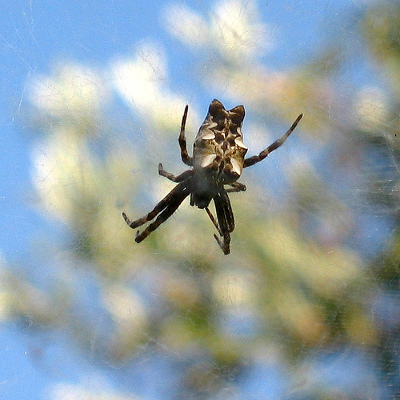Tent-Web Spiders
Category: Arachnida Spider

Facts about Tent-Web Spiders, "Scientific name for Tent-Web Spiders is Cyrtophora citricola". There are a variety of Tent-Web Spiders. The Tropical Tent-Web Spider is an araneid spider that commonly occurs in warmer parts of Africa, Asia, and Europe, but can also be found in Costa Rica, Colombia, Australia, and Hispaniola.
The Tent-Web Spiders belong to the family commonly known as Orb Web Spiders, though unlike the other members of this family, they do not build orb webs. Instead they build a horizontal web that forms a cone-like shape in the middle and with many we lines support. Tent-Web Spider web is not sticky, the spirals and radials are generally constructed from the same silk
Physical Description of Tent-Web Spiders
Tent-Web Spider color vary greatly; though many have been spotted in sported black and white pattern, while others are brown, and males at times appear black. The Tent-Web Spider are 3mm when fully grown.
The female Tent-Web Spider can sometimes resemble a part of dead leaf, and sometimes like to hide in debris which falls onto the web. When fully grown they can reach a length of 10 mm. The immature female Tent-Web Spider will have green legs and a few areas of bright orange color on their body.
They also got the ability to change their body color rapidly.
Spiders belong to a group of animals called "arachnids", mites and Scorpions and a tick is also in the arachnid family. An Arachnids is a creature with eight legs, two body parts, no antennae or wings and are not able to chew on food. Spiders are not insects because insects have three main body parts and six legs and most insects have wings. The Arachnids are even in a larger group of animals called "arthropods" an invertebrate animal of the large phylum Arthropoda, which also include spiders, crustaceans and insects. They are the largest group in the animal world, about 80% of all animals come from this group. There are over a million different species. There are more than 40,000 different types of spiders in the world.
Tent-Web Spiders have oversize brains.
In the Tent-Web Spider the oxygen is bound to "hemocyanin" a copper-based protein that turns their blood blue, a molecule that contains copper rather than iron. Iron-based hemoglobin in red blood cells turns the blood red
Characteristics of Tent-Web Spiders
Many Tent-Web Spiders females can build webs in close vicinity, and can live in a colony of even one hundred individuals. It is observed that the Tent-Web Spider can catch equal amount of prey with their smaller webs compared to other solitary specimens. The colonies are often made up of offspring of a single Tent-Web Spider female, which did not disperse after they hatched.
The male Tent-Web Spider adults don’t build webs and stops eating. They die soon after mating, though the females may live long enough to safeguard the young ones they some times die even before they hatch.
There are several Tent-Web Spider species available and may vary in terms of physical appearance and other characteristics.
Female spiders are usually bigger than males.
Female Tent-Web Spiders lay eggs on a bed of silk, which she creates right after mating. Once the female Tent-Web Spider lays her eggs, she will than cover them with more silk.
Tent-Web Spiders have two body parts, the front part of the body is called the Cephalothorax-(the thorax and fused head of spiders). Also on this part of the body is the Tent-Web Spider’s gland that makes the poison and the stomach, fangs, mouth, legs, eyes and brain. Tent-Web Spiders also have these tiny little leg-type things called (pedipalps) that are next to the fangs. They are used to hold food while the Tent-Web Spider bites it. The next part of the Tent-Web Spiders body is the abdomen and the abdomens back end is where there is the spinnerets and where the silk producing glands are located.
The muscles in a Tent-Web Spiders legs pull them inward, but the spider can't extend its legs outward. It will pump a watery liquid into its legs that pushes them out. A Tent-Web Spider’s legs and body are covered with lots of hair and these hairs are water-repellent, which trap a thin layer of air around the body so the Tent-Web Spiders body doesn't get wet. It allows them to float, this is how some spiders can survive under water for hours. A Tent-Web Spider feels its prey with chemo sensitive hairs on its legs and than feels if the prey is edible. The leg hair picks up smells and vibrations from the air. There are at minimum, two small claws that are at the end of the legs. Each Tent-Web Spiders leg has six joints, giving the Tent-Web Spider 48 leg joints. The Tent-Web Spider’s body has oil on it, so the spider doesn't stick to it’s own web.
A Tent-Web Spiders stomach can only take liquids, so a Tent-Web Spider needs to liquefy their food before they eat. They bite on their prey and empty its stomach liquids into the pray which turns it into a soup for them to drink.
A male Tent-Web Spider has two appendages called "pedipalps" a sensory organ, instead of a penis, which is filled with sperm and insert by the male into the female Tent-Web Spider’s reproductive opening.
Tent-Web Spiders do not have a skeletons. They have a hard outer shell called an exoskeleton-(a rigid external covering for the body in some invertebrate animals). The exoskeleton is hard, so it can’t grow with the spider. The young Tent-Web Spiders need to shed their exoskeleton. The spider has to climb out of the old shell through the cephalothorax. Once out, they must spread themselves out before the new exoskeleton will harden. Know they have some room to grow. They stop growing once they fill this shell.

 Back To Category Arachnida Spider
Back To Category Arachnida Spider